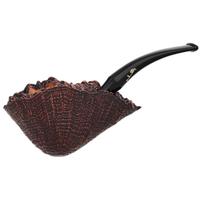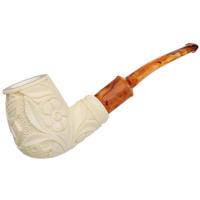Ox Blood is a coloring agent. Now I am open to be corrected here as what I am about to say is based on here say, stuff that people have told me who are now long since dead. My understanding that coloring was applied to pipes and was the same sort of stuff used to make those 'Shit Brown' colored tiles you see on the outside of older London Underground Stations in London. I believe it was painted on with a fine brush and then fired at a low heat. Others have told me it was done with a lamp and some sort of Iron Oxide based pigment. I have a few pipes where you can definitely see this types to activity but then I have a few that have colored that way with the line between the brown color and the white bowl caused by restrictor in the base of the bowl.
I remember seeing a pair of unsmoked meers that had been Oxblooded on the bay years ago. A definate resemblance to the 'iron oxide' colour you mentioned. I'd love to know how they did it but perhaps we'll never know for sure as the practice has like you say dissapeared from living memory.
Funny you noticed the similarity with the 'shit brown' tiles on the Tube. After googling oxblood turns out that's what the architect wanted for the Tube stations. Although he described the colour not as Oxblood or Shit brown but 'Sang de Boeuf'.Probably charged tuppence a tile extra for that as it sounds a bit posher. Lol
From Wikipedia,
From 1903, the English architect
Leslie Green used an industrial, solid, sang de boeuf glaze on the
glazed architectural terra-cotta tiles for the exteriors of the stations of a large part of the
London Underground system, which was then divided between a number of commercial companies. His employer, the
Underground Electric Railways Company of London was building the
Great Northern, Piccadilly and Brompton Railway, the
Baker Street and Waterloo Railway and the
Charing Cross, Euston and Hampstead Railway, which are now respectively sections of the
Piccadilly line,
Bakerloo line and
Northern line. The
Leeds Fireclay Companymade the tiles.
[11]





















